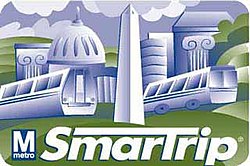SmarTrip
 |
|
| Location | Baltimore–Washington metropolitan area |
|---|---|
| Launched | May 18, 1999 |
| Currency | USD ($300 maximum load) |
| Validity | |
| Retailed |
|
| Variants |
|
| Website | https://www.smartrip.com/rcsc.html |
SmarTrip is a contact-less stored-value smart card payment system managed by the Washington Metropolitan Area Transit Authority (WMATA). The Maryland Transit Administration (MTA) uses a compatible payment system called CharmCard. A reciprocity agreement between the MTA and WMATA allows either card to be used for travel on any of the participating transit systems in the Baltimore-Washington metropolitan area. Unlike traditional paper farecards or bus passes, SmarTrip/CharmCard is designed to be permanent and reloadable. For the rest of this article, "SmarTrip" will refer to both unless there is a specific difference between the two.
WMATA began using SmarTrip for payment on Metrorail in 1999 followed shortly by Metrobus and Metro parking lots. It was later extended to other public transit systems throughout the region. SmarTrip users receive discounts on Metrorail fares. Although WMATA initially drew criticism due to the limited number of SmarTrip sales locations, distribution has expanded to local convenience stores and supermarkets. By late 2012 all Metrorail stations were equipped with SmarTrip vending machines.
In October 2010, WMATA announced that it was working on a replacement system because the company that makes SmarTrip cards has since gone out of business. However, the transit agency found an alternate manufacturer to produce additional cards until a new payment system is introduced. Since March 6, 2016, SmarTrip cards are the only Metrorail payment method, and paper farecards are no longer be accepted.
SmarTrip cards are 3⅜ by 2⅛ inches (85.7 mm × 54.0 mm), roughly the same size as a credit card or driver's license. The card is brought into close proximity with a circular target on the top or side of each faregate rather than inserted into a slot. Because the card has a radio-frequency identification (RFID) chip inside, it only has to be in close proximity to the target and is usually not necessary to actually touch it with the card, although it can be touched to the target if desired, or the card can be scanned while still inside a wallet or purse passed over the target, affording some speed and convenience over the paper farecard which must be physically inserted into a slot. In the Metrorail system, touching the card to the target will display the value remaining as the faregate opens, both when entering and exiting. On Metrobuses, the farebox will audibly beep and display the remaining value. In all cases, the appropriate fare is deducted automatically, accounting for any applicable transfers and discounts.
...
Wikipedia
